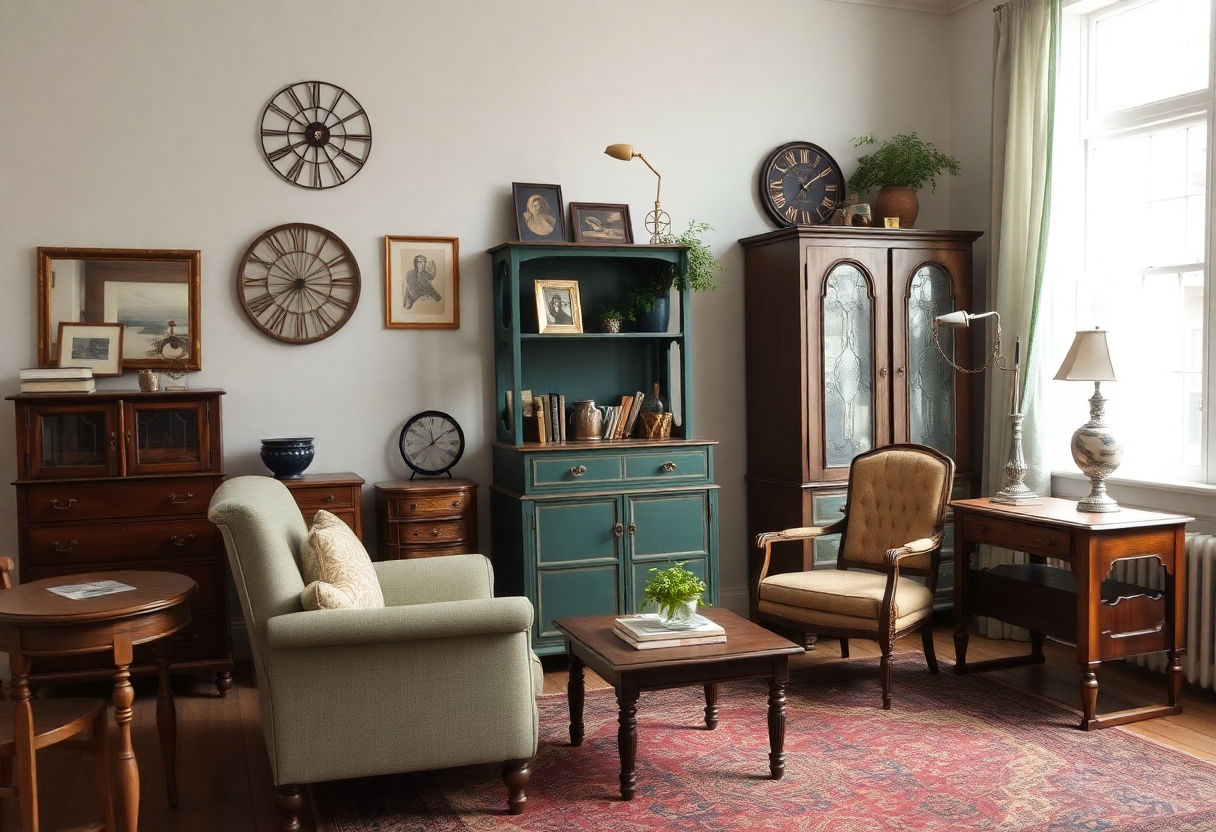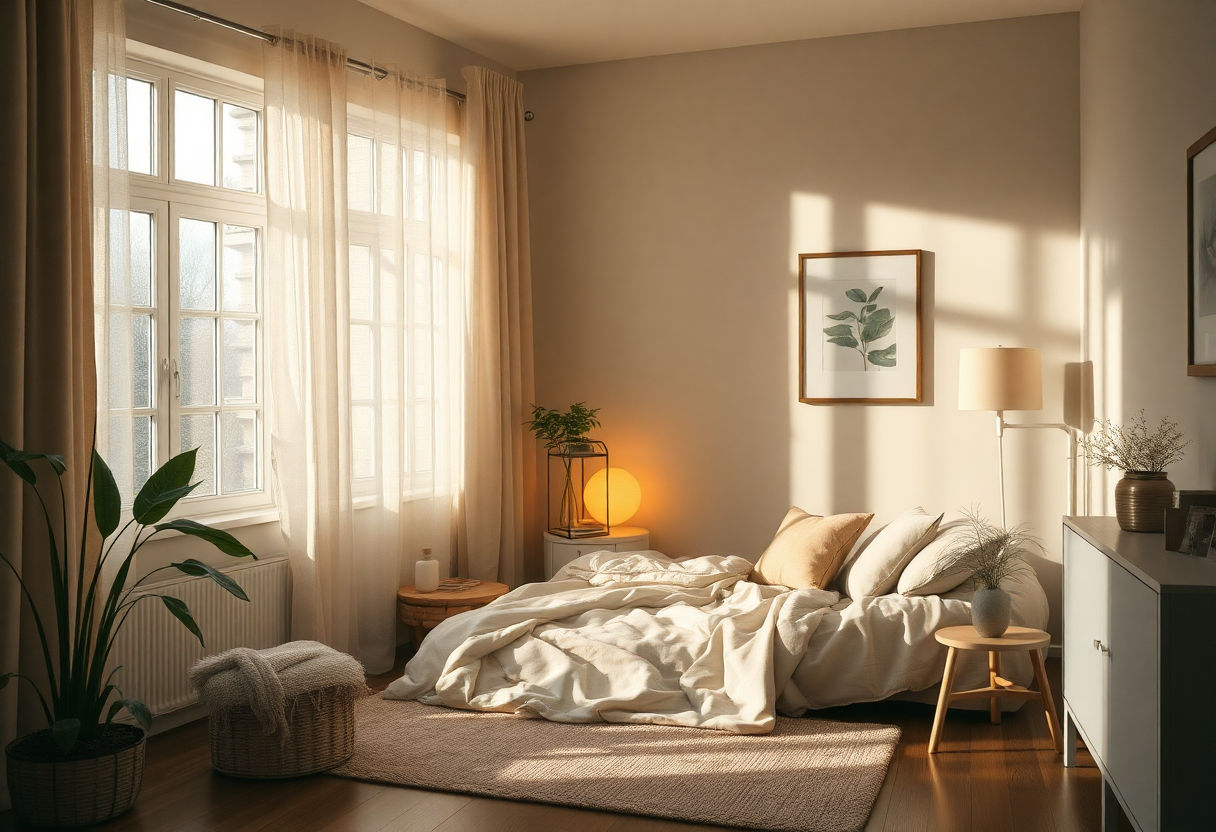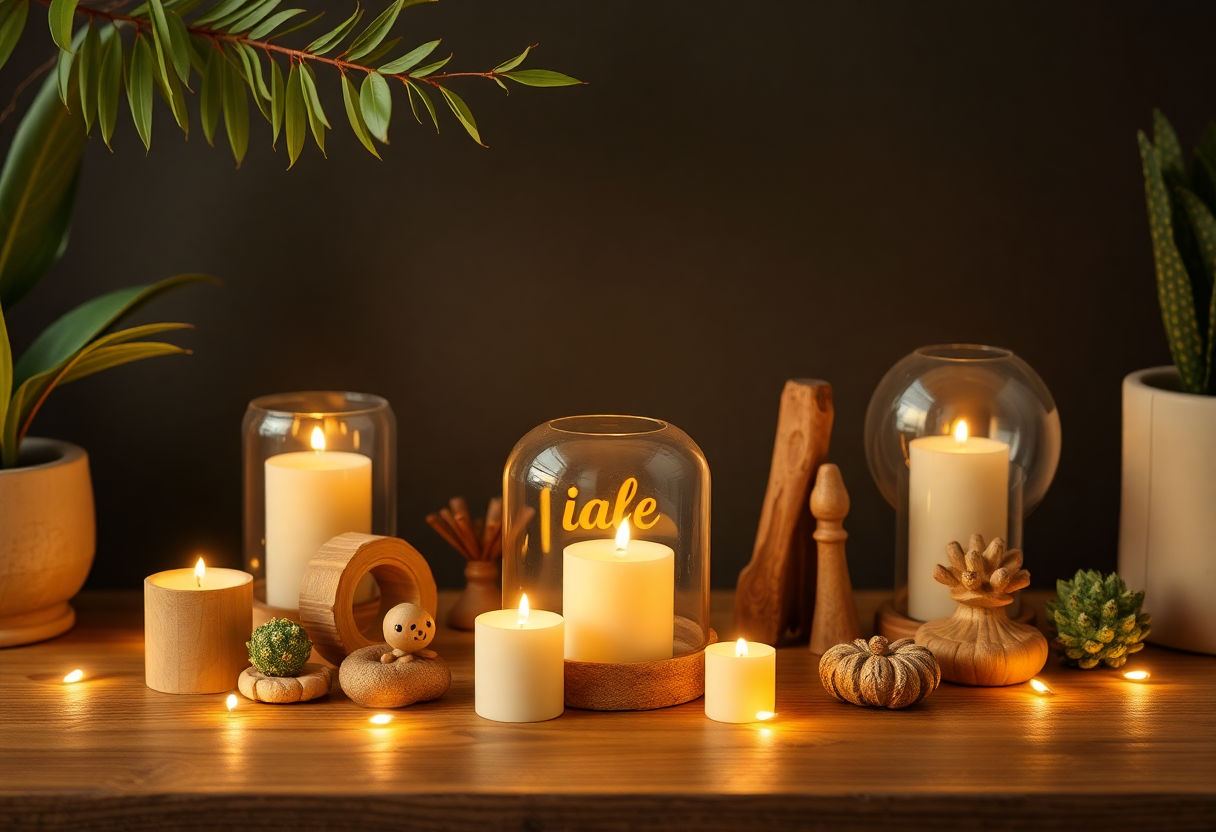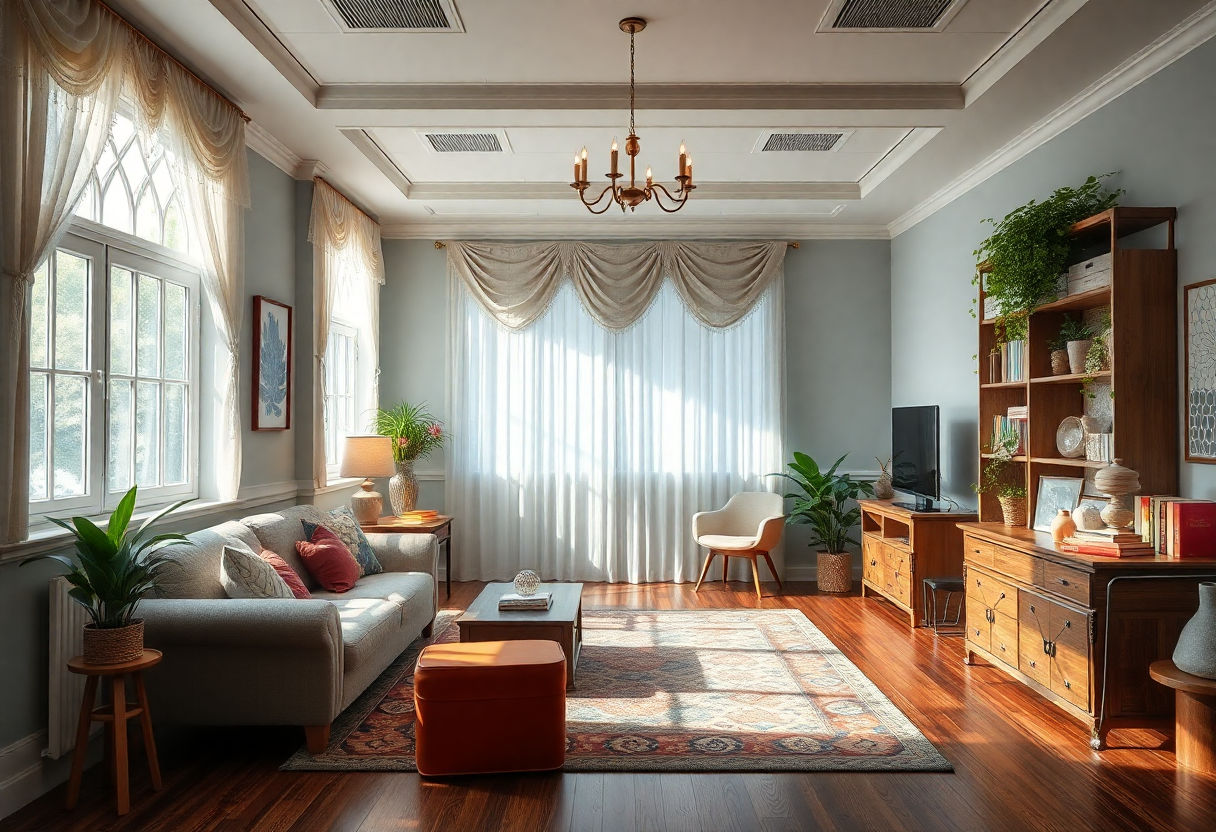Transform your living space into a light academia haven, where elegance meets intellectual charm. This aesthetic celebrates a harmonious blend of warm neutrals and soft pastels, inviting an ambiance of serenity and sophistication. Discover how to select the ideal furniture and textures, infusing your home with the allure of vintage allure and contemporary comfort. Enhance your decor with elements such as classic literature and art, breathing life into your interior with both natural and artificial lighting. Embrace personalization, adding unique touches that reflect your style. These steps will guide you to craft a timeless environment that is both inviting and inspiring.
Key Takeaways
- Embrace a warm and inviting atmosphere by choosing color palettes inspired by light academia, focusing on soft pastels and warm neutrals.
- Select furniture that reflects a vintage or antique aesthetic, enhancing the elegance and timeless feel of the space.
- Enhance your environment by layering textures such as wood, leather, and textiles, which add depth and interest.
- Incorporate elements of classic literature and art to create an intellectual and culturally rich ambiance.
- Personalize your space with plants and sentimental decor pieces to infuse vitality and a personal touch.
Understanding Light Academia
The light academia aesthetic enchants with its emphasis on scholarly elegance and romantic introspection, offering a visual and metaphorical escape into a world of contemplation and beauty. This style, deeply rooted in the European academic heritage of the 19th and early 20th centuries, celebrates intellectual pursuits and the serene ambiance of elite scholarly institutions. Light academia diverges from dark academia by prioritizing soft, airy tones over the somber, shadowy colors associated with its counterpart. It’s an aesthetic that draws inspiration from classical architecture, literature, and art, bridging historical grandeur with modern comfort.
A key element of light academia lies in its color schemes, which typically revolve around muted tones and pastel shades. The palette often includes:
- Creamy whites
- Beige and taupe
- Pale yellows and soft browns
These colors capture the gentle light of a sunlit study, bringing warmth and tranquility into everyday spaces.
Historically, light academia’s visual elements celebrate the works of romantic poets and classical philosophers, conveying a sense of timeless elegance. This style sets itself apart by incorporating a lighter atmosphere, focusing more on the intellectuality and beauty of literature, art, and soft palettes rather than the darker, brooding undertones of its sibling.
A proper understanding of light academia is fundamental to recreating an environment that balances both visual appeal and scholarly substance. By weaving these historical and aesthetic threads into your living space, you create not only a haven of beauty but a reflection of personal intellectual pursuits and appreciation for the nuanced artistry of the past.
Choosing the Right Color Palette

Selecting the right color palette is a foundational step in creating a light academia haven. This aesthetic draws inspiration from classical European elements and combines them with a soft, intellectual touch. Warm neutrals and soft pastels are at the heart of this decor style, providing the perfect backdrop for a serene and inviting space.
Warm neutrals, such as cream, beige, and taupe, offer a timeless appeal. These colors are versatile and can create a grounded atmosphere when used as the primary wall color or in larger furniture pieces. These tones evoke a sense of calmness and stability, making them ideal for your light academia sanctuary.
Soft pastels add a gentle elegance to the palette. Colors like dusty pink, muted sage, and pale lavender introduce subtle hints of color without overpowering the overall look. These shades can be employed in accent pieces, such as cushions, throws, or even an art print, allowing for a delicate pop of color that complements the more neutral tones.
For those seeking a touch of contrast, consider incorporating darker accent colors like deep navy or charcoal. These colors can be used sparingly in decor elements such as picture frames or decorative items. This contrast not only highlights the lighter colors but also adds depth and sophistication to the space.
In essence, the careful selection of colors in your light academia haven serves to evoke an atmosphere that is both intellectually stimulating and visually harmonious. The balance achieved through these color choices is instrumental in realizing a space that is as thoughtful as it is beautiful.
Furniture Selection

When selecting furniture to create a light academia haven, the focus should be on pieces that embody a sense of timelessness and understated elegance. Opt for vintage or antique furniture that reflects the historical essence of the light academia aesthetic. Such pieces often bring intricate details and craftsmanship that modern styles lack.
Consider incorporating wooden furniture with a warm, natural tone. Woods like mahogany, oak, and walnut can infuse your space with depth and sophistication. Look for items like roll-top desks, ornately carved bookshelves, or Victorian-style chairs, which add character and charm.
Balance vintage elements with function by selecting practical items that serve a purpose in your daily life. A classic writing desk or an antique coffee table not only enhances the aesthetic but also supports a lifestyle steeped in intellect and curiosity.
Upholstery and fabrics should be chosen with care, focusing on materials like leather, velvet, or linen in muted, neutral hues. These materials add a layer of luxury and comfort without overwhelming the space. Delicate floral patterns or subtle stripes can complement the restrained color palette typical of light academia style.
Accent your furniture selection with accessories such as antique lamps, elegant vases, and soft throw blankets. These elements can contrast with the furniture’s robust nature, creating a harmonious blend of old-world charm and modern utility. By thoughtfully selecting and combining these pieces, you can craft a living space that is both functional and deeply inspiring.
Layering Textures
Layering textures is pivotal in achieving the light academia aesthetic, as it establishes depth and warmth in any living space. Start by incorporating a variety of wood finishes, each adding a distinct element of nature and history. Opt for oak or walnut, which provide rich undertones, ideal for a cozy yet refined setting.
Introduce leather accents to your decor, such as a vintage armchair or leather-bound books, to convey an air of timeless sophistication. The supple feel of leather enriches the environment, enhancing the overall tactile experience.
Textiles play a crucial role in layering. Consider using a mix of cotton, linen, and wool to create a tactile and inviting atmosphere. A linen sofa paired with woolen throws or cotton cushions can effortlessly infuse comfort and elegance into your space. Rug choices are equally important; select Persian or Oriental rugs to inject subtle color and pattern, grounding the room in tradition and culture.
For wall treatments, think of adding texture through wallpaper or paint. Subtle embossed patterns or muted color washes can offer a visual layer without overwhelming the senses. Don’t overlook the potential of exposed brick or plaster walls, which provide an authentically aged look aligning with the aesthetic’s affinity for classicism.
Finally, consider the integration of natural elements. Incorporate materials like marble or terracotta in decor items or surfaces. These elements not only add to the textural layers but also establish a connection with the earth, further enhancing the tranquil and intellectual sanctuary that is the hallmark of a light academia haven.
Incorporating Classic Literature and Art
Incorporating classic literature and art into your light academia haven allows you to create an intellectually stimulating and visually appealing environment. Begin by displaying beloved books. Consider stacking a few favorite hardcover classics on side tables or shelving units to serve as both decor and conversation starters. For a more cohesive look, select books with elegant binding that complement your color scheme.
Adding art prints influenced by the European Renaissance, Romanticism, or Neoclassicism can enhance the academic aesthetic. Choose pieces that feature timeless themes and subjects, such as landscapes or portraits. Frames should be kept simple and elegant, with gold or dark wood finishes, to maintain a classic yet refined ambiance.
Include sculptural elements to inject three-dimensional intrigue. Busts of literary figures, philosophers, or mythological characters can provide an air of intellectual grandeur and serve as focal points in a room. Position these sculptures on mantels or within bookcases to give depth to your space.
When selecting pieces, focus on the stories and emotions they evoke. For instance, consider integrating a quote by a favorite author displayed in an ornate frame. This personalization not only enhances the aesthetic but also breathes life into the space.
Moreover, engaging objects such as a globe or antique map can further underscore the adventurous spirit synonymous with the light academia style. These elements, steeped in history, invite exploration, echoing the scholarly essence of the aesthetic.
Lighting and Ambiance

Creating a light academia haven involves carefully curated lighting and ambiance to nurture a space that is both warm and inviting. The artistry of this aesthetic lies in blending natural and artificial lighting to enhance an elegant yet lived-in atmosphere reminiscent of historic academic institutions.
To achieve this, prioritize natural light by positioning seating areas and study spots near large windows. This not only highlights the soft hues typical of light academia but also harmonizes with the tranquil essence of the exterior. Consider installing sheer curtains that gently filter and diffuse sunlight, creating a mellow glow throughout the room.
For artificial lighting, select fixtures that serve both functional and decorative purposes. Lamps with vintage or classic designs—such as brass desk lamps or chandeliers with soft, warm bulbs—can be particularly effective in fostering a cozy ambiance. The key is to opt for warm white bulbs, ideally within the range of 2700K to 3000K, which mirror the soothing light of sunset and complement the color palette typical of the light academia aesthetic.
Additionally, incorporate multiple sources of light to layered effect, ensuring each area of the room can be individually highlighted. This approach mimics the nuanced play of light in historic libraries and study halls, emphasizing different areas as the mood requires.
The strategic combination of both lighting types fosters an atmosphere where shadows dance gently across the walls, and every corner invites repose and reflection, perfectly encapsulating the refined and contemplative spirit of light academia.
Accessorizing with Plants and Nature

Engaging with the light academia aesthetic through natural elements can significantly enhance the vibrancy and freshness of your living space. Plants, with their dynamic textures and calming hues, play an integral role in this transformation. Opt for delicate ferns, elegant ivy, and subtle succulents that align with the soft color palette typical of light academia. These plants not only purify the air but also complement the understated elegance of the style.
Moreover, consider the strategic placement of hanging plants to add depth and interest without overwhelming the space. Wall-mounted planters or small wooden shelves can serve as perfect platforms for cascading greenery.
A key aspect of incorporating nature is to ensure a harmonious blend with other elements. Complement the natural greenery with natural materials such as wood and stone. An antique bookshelf paired with small potted plants or a marble table adorned with a vase of fresh flowers embodies this synergy beautifully.
Decorative elements such as dried flowers, pressed botanicals in vintage frames, or artisanal clay pots further enhance the natural charm. These accessories can introduce just the right amount of rustic elegance that light academia aspires to achieve.
Lighting also interplays significantly with these natural embellishments. Soft, filtered light through sheer curtains can accentuate the greenery, creating captivating shadows and highlights. This not only nourishes the plants but also sets a tranquil, inviting ambiance that is quintessential to a light academia haven.
The Role of Personalization

Personalization plays a pivotal role in crafting a light academia haven, transforming a simple space into a reflection of your unique personality and experiences. By incorporating personal artifacts and sentimental décor items, you can create a space that not only embodies the light academia aesthetic but also resonates with your individual story.
One effective way to personalize your environment is through the inclusion of heirloom pieces. These items, laden with personal history, can add depth and character to your space. Whether it’s a vintage vase passed down through generations or a cherished family portrait in an ornate frame, these elements can seamlessly blend with the light academia theme.
Additionally, consider using souvenirs from travels or mementos from significant life events as part of your décor. Items such as handwritten letters, travel journals, or antique trinkets can imbue your surroundings with meaning and a sense of nostalgia. Display these pieces thoughtfully on shelves or coffee tables to create focal points that invite stories and conversations.
Incorporating a gallery wall dedicated to personal art and photography can also enhance your light academia setting. Choose frames that complement the warm neutrals or soft pastels characteristic of this style. Such a display not only serves as a visual centerpiece but also celebrates your creative journey through life.
Ultimately, personalization is about striking a harmonious balance between aesthetic qualities and personal significance, allowing your light academia haven to evolve into a sanctuary that is both elegant and intimately yours.
Conclusion
In crafting a light academia haven, the key lies in harmonizing elegance with comfort. By embracing warm neutrals, rich textures, and thoughtful personal touches, you can transform your space into a sanctuary of intellectual beauty. This aesthetic not only enhances your living environment but also nurtures an inspiring atmosphere for reflection and creativity. As you experiment with this style, remember to stay attuned to your unique preferences, allowing your home to evolve as a genuine extension of your personality. Embrace the timeless charm of light academia to create a truly inviting and introspective retreat.
Frequently Asked Questions
How can I maintain the light academia aesthetic without constant upkeep?
Maintaining a light academia aesthetic involves choosing durable, timeless pieces and regularly decluttering to keep the space serene and organized. Incorporating easy-care plants and routinely dusting can also preserve the style’s elegance.
What are some budget-friendly ways to achieve a light academia look?
Thrift stores and flea markets offer vintage and antique furniture at a lower cost, crucial to achieving this aesthetic. Additionally, you can DIY soft pastel or neutral accents, such as repainting or upcycling existing furniture.
Is it necessary to include classic literature and art to embody the light academia vibe?
While not strictly necessary, classic literature and art enrich the intellectual ambiance associated with light academia. Choose pieces that resonate personally or find affordable prints to complement your decor.
Can I adapt the light academia style to smaller living spaces?
Absolutely, by focusing on a few key furniture pieces and utilizing vertical space for books or art. Opt for light colors to create an illusion of space and incorporate mirrors to enhance natural light.
Does light academia decor work outdoors or only indoors?
Light academia decor can seamlessly extend to outdoor spaces by using vintage-inspired outdoor furniture, soft lighting, and plants. The goal is to create a cohesive transition between indoor and outdoor aesthetics.



